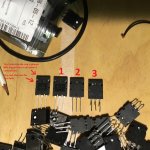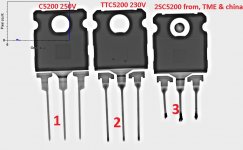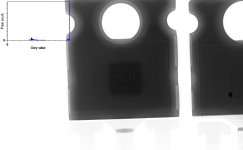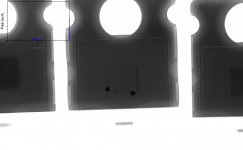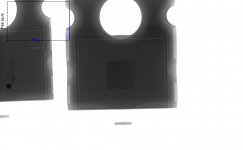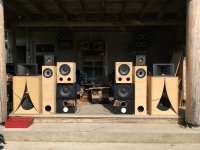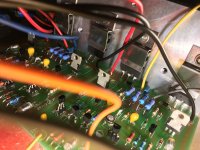two 70W channels will work with a transformer anywhere from 140VA to 280VA........... what size transformer would you suggest? Would 200VA be sufficient to cover 70w*2 or would it be better (safer) to run a higher margin such as 300VA?
There should be a very small increase in performance in using the high end of that range. There will be almost no improvement in performance by going above that range.
On that basis 200VA, 250VA and 300VA should all give performance is that nearly identical. Only continuous two channel maximum power testing will show small differences.
The transformer is rated for each model. That which was fitted to the little NAP90 was, according to a Julian Vereker interview, only 90VA. That for the NAP140 was about 240VA and that for the NAP250 was huge, probably 500VA or more, due to extra losses in regulation.
Your 70W/4 ohms rating probably ties in with the real NAP140 (not the NAP250 you see everywhere credited as a NAP140 clone). As per the original, +/- 34V rails and 250VA rating would seem a nice combination. The closest you will get with commonly available, off-the shelf types would have dual 25VAC secondary windings which would be wired in series, noting the correct arrangement of connecting the leads for this. The centre-tap formed in this series of windings is also connected to common ground of the power supply. That results in roughly +/-35VDC supplies with a simple bridge reactifier supply as per the original. Details and suggestions here: Modifying Naim Audio power amplifiers
There is a little confusion over transformer ratings these days since transformer ratings have been altered to accommodate a "harmonised" 230VAC mains supply rating. That is really only a paperwork change for the mains grid but it means that 230V mains rated transformers will have secondary voltages that run about 4% higher than expected on our nominal 240V grids. In Europe and China where the grids are mostly 220V, their voltages will be lower instead. In any case, 250VA would still be ideal but a standard 300VA rated job shouldn't do any harm other than occupy more space and weigh more. Your real amplifier won't actually require much power at all. Even a standard 160VA transformer will be fine with 8 ohm speakers used at realistic domestic sound levels.
There are some interesting facts about thermal stability and use of the thick, closed aluminium case as a heatsink with NAP models. Don't just assume that a standard amplifier layout with a separate heatsink will be a better idea for bias stability. The system works well for a Quasi-complementary design and Naim's in particular, once the amplifier is warm - no need to leave the thing on 24/7 and run a fire risk with your DIY designs, though
Your 70W/4 ohms rating probably ties in with the real NAP140 (not the NAP250 you see everywhere credited as a NAP140 clone). As per the original, +/- 34V rails and 250VA rating would seem a nice combination. The closest you will get with commonly available, off-the shelf types would have dual 25VAC secondary windings which would be wired in series, noting the correct arrangement of connecting the leads for this. The centre-tap formed in this series of windings is also connected to common ground of the power supply. That results in roughly +/-35VDC supplies with a simple bridge reactifier supply as per the original. Details and suggestions here: Modifying Naim Audio power amplifiers
There is a little confusion over transformer ratings these days since transformer ratings have been altered to accommodate a "harmonised" 230VAC mains supply rating. That is really only a paperwork change for the mains grid but it means that 230V mains rated transformers will have secondary voltages that run about 4% higher than expected on our nominal 240V grids. In Europe and China where the grids are mostly 220V, their voltages will be lower instead. In any case, 250VA would still be ideal but a standard 300VA rated job shouldn't do any harm other than occupy more space and weigh more. Your real amplifier won't actually require much power at all. Even a standard 160VA transformer will be fine with 8 ohm speakers used at realistic domestic sound levels.
There are some interesting facts about thermal stability and use of the thick, closed aluminium case as a heatsink with NAP models. Don't just assume that a standard amplifier layout with a separate heatsink will be a better idea for bias stability. The system works well for a Quasi-complementary design and Naim's in particular, once the amplifier is warm - no need to leave the thing on 24/7 and run a fire risk with your DIY designs, though
Last edited:
Thanks for all the detailed information. I've scoured the forum posts and google for hours looking to find a definitive statement on power supplies and suggested rating.
Ian, I definitely agree with your statements:
I am betting that the Sanken transistors provided are probably knock-offs. That is a later research project!
I'm desperately denying the urge to get stuck into the 'mod bible' over on acoustica. Baby steps though, let's get this amp fired up and happy before the tinkering begins!
Ian, I definitely agree with your statements:
I doubt your build will be using the original (genuine) transistors marked on the schematic
I am betting that the Sanken transistors provided are probably knock-offs. That is a later research project!
Now, newcomers to DIY also mess about with their own ideas of what they think are better parts right from the outset and of course, voltages go haywire and often burn with the wrong pinout or wrongly fitted parts.
I'm desperately denying the urge to get stuck into the 'mod bible' over on acoustica. Baby steps though, let's get this amp fired up and happy before the tinkering begins!
avtech23,
I would suggest you to not modify anything in this kit, Seller of that kit allready picked the right transistors for you, if you are lucky
I have recently purchased 3 Types of 2SC5200 transistors.
1. is from farnell C5200 - onsemi
2. is from farnell TTC5200 - Toshiba ?
3. is from TME&china 2SC5200 - Japan.
3nd one is the most common and from chinese/ebay/taydaelectronics, all nr. 3 2SC5200 sourced from these places look, feel and behave the same.
I am conserned about nr. 1 & 2 transistors on the pic, especially with nr. 2 which has 2 dots near the die ??
Nr. 1 seems like short-circuited, its not in practice... on photos it seems that bonding wires are alot closer to each other
Last photo represents speaker comparision, were mine are the eminence beta 10 CX sitting on top of the black coloured speakers.
To bad i had no true naim or naim clone with me that time.....
Carlsons sounded very powerful, eminence was faster, better acoustical perfomance, especially in human vocal range. Next year will try to re-tune speaker box, increase volume and alter some filter components. It does feel that i have tuned the box too low in frequency.
Some tough's about transistors?
I would suggest you to not modify anything in this kit, Seller of that kit allready picked the right transistors for you, if you are lucky
I have recently purchased 3 Types of 2SC5200 transistors.
1. is from farnell C5200 - onsemi
2. is from farnell TTC5200 - Toshiba ?
3. is from TME&china 2SC5200 - Japan.
3nd one is the most common and from chinese/ebay/taydaelectronics, all nr. 3 2SC5200 sourced from these places look, feel and behave the same.
I am conserned about nr. 1 & 2 transistors on the pic, especially with nr. 2 which has 2 dots near the die ??
Nr. 1 seems like short-circuited, its not in practice... on photos it seems that bonding wires are alot closer to each other
Last photo represents speaker comparision, were mine are the eminence beta 10 CX sitting on top of the black coloured speakers.
To bad i had no true naim or naim clone with me that time.....
Carlsons sounded very powerful, eminence was faster, better acoustical perfomance, especially in human vocal range. Next year will try to re-tune speaker box, increase volume and alter some filter components. It does feel that i have tuned the box too low in frequency.
Some tough's about transistors?
Attachments
Last edited:
Rensli,
Just looking to start with a couple of capacitor changes first. I've ordered some low ESR Panasonic FM series caps to carry out the output decoupling mod. Next I'll try upgrading the C2 to a Metallised Polyester Film.
On the subject of caps, does anyone know where to get hold of some decent 47uF MPF? The recommendation was to use EVOK MMK 47uF or 68uF 50v, but these seem to be in the category of hen's teeth. Is there an alternative that would be suitable?
Hope your transistors aren't bad. May I ask how you took the pictures? They look like xrays!
Looking at the pics on Counterfeit Transistors, it seems mine will turn out to be fakes (the font looks nicer than the 'real' ones). Still, we'll see if they are functional.
I'd love the space to have so much audio equipment to experiment with!
Just looking to start with a couple of capacitor changes first. I've ordered some low ESR Panasonic FM series caps to carry out the output decoupling mod. Next I'll try upgrading the C2 to a Metallised Polyester Film.
On the subject of caps, does anyone know where to get hold of some decent 47uF MPF? The recommendation was to use EVOK MMK 47uF or 68uF 50v, but these seem to be in the category of hen's teeth. Is there an alternative that would be suitable?
Hope your transistors aren't bad. May I ask how you took the pictures? They look like xrays!
Looking at the pics on Counterfeit Transistors, it seems mine will turn out to be fakes (the font looks nicer than the 'real' ones). Still, we'll see if they are functional.
I'd love the space to have so much audio equipment to experiment with!
Hope your transistors aren't bad. May I ask how you took the pictures? They look like xrays!
They actually might not be bad yep, i have not used NR 1 and 2 in circuits yet.
Maybe someone knows here why some DIE's are not perfectly straight edged like nr 3.
Its hard to find good THT/transistors
Going SMD would be a much better idea, especially if searching for small signal to medium power transistors.
I would still not recommend to change components in that kit.
MIMIC naim as close as possible, alu. case, voltages and current in different stages, transistor types used, for example epitaxial, tripple diffused.
Also, nothing sounds better then plain 2x10mF per channel or even better, a regulator board. HIGH FT/Gain Vas and Outputs would be my choise for naim topology.
Hi Rensli, are you referring to the chip dimensions or the backplate when you say "die size"? They are indeed different to the Japanese products internally, as you may be saying. The Chinese Toshiba products (that's TTC5200/TTA1943) are about 30% smaller in silicon die area than the original Japanese 2SC5200/2SA1943 yet both types come in the large TO264 case. The laser printing is likely to be a little different between the factories, which you can also see in some pics on the web.
The laser printing is likely to be a little different between the factories, which you can also see in some pics on the web.
Yep, Chip's differ in mounting, a little bit in shape and position... and from other artifacts...
all three different 2SC5200 transistors had the same chip dimensions aka die size ?? ... except MJL21194G from on-semi, stronger, bigger.
'Interesting about your experience with BC239 for the input LTP transistors. In my experience, these weren't fitted to all models and of course, they are obsolete and now, all NOS parts are suspect. I do have some old stock of various BC type audio parts including a few of these, bought when they were still in production and the price was right. Whatever choice you make though, it is also important to get the amplifier's DC offset voltage within reasonable limits like, say +/-15 mV, so we need to mismatch the Hfe measurement of the pair such that we get the lowest possible absolute value. That will require a number of parts to select by measurement or trial and error, unless you have more than a DVM.BC239C transistors, these are also essential part of the circuit, without them its just not enaugh musical
2N5089 is a similar low-noise component from On-Semi and is supplied in the Caowei NAP200 clones, which sound superb with a little tinkering.
The ZTX652 or 653 and ZTX752 or 753 VAS transistors certainly are essential for real Naim sound quality and they're fitted in every NAP and Nait model I've seen. I'm not sure about the newer "super nait" and "i" series though - they seem altogether different in design while parts and technology have moved on in the last 45 years.
BTW, I made an error in the transformer rating of the real NAP140 earlier. I understand it is the same as that in NAP110 and only about 145VA, so for 70W/4 ohms , a standard 160VA transformer with 2 x 25VAC windings should be fine and certainly much cheaper and smaller than a 300VA affair. I would fit separate bridge rectifiers to the +/- supply rails, though.
The ZTX652 or 653 and ZTX752 or 753 VAS transistors certainly are essential for real Naim sound quality
ZTX753/653 paired with MJE25x series drivers gives very good drive on the output, balanced feeling.
I have tried everything in LTP positions, long and short listening... nothing beats BC239C transistors.
Second best is BC550B PH03, these are also vintage, never seen them anywhere....
2N5089 is a similar low-noise component from On-Semi and is supplied in the Caowei NAP200 clones, which sound superb with a little tinkering
I have these, you suggest to try them on the input LTP ??? I use them in VBE positions.
The essential features of BC239C is that it has high Hfe, >600 and a very low noise figure as well. That's hard to find in current products and is a fair test for genuine parts. Naim's would originally have come from Texas Instruments in the UK, like the BC384, 184, 214 used in preamps, I believe). Another consideration is the PCBs are made for the US style EBC pinout and Philips BC types were CBE pinout, so they could need reversing - this a trap for anyone who thinks all the Prolectron BC series are the same.
BC550C is good but gain has to be selected to match that. There are plenty of so-so audio transistor fakes/copies of these out there on Ebay. Typically they are all much the same part, with medium noise and gain performance - nothing outstanding, at best like a simple BC550. What would be nice to find among the trash, are the really good Hitachi 2SC2545,6,7E series transistors which are long obsolete but highly regarded since long ago and still fetch good prices. https://4donline.ihs.com/images/VipMasterIC/IC/HITJ/HITJS12201/HITJS12201-1.pdf
I don't know how 2N5089 would go in your build, other than I suggest you look for really high gain among the choices you have - anything available in low noise types. I have been looking at what is available in SMD types but the choices are nothing special for this purpose. Good luck and tell us what you find in through-hole types because I haven't been successful so far.
BC550C is good but gain has to be selected to match that. There are plenty of so-so audio transistor fakes/copies of these out there on Ebay. Typically they are all much the same part, with medium noise and gain performance - nothing outstanding, at best like a simple BC550. What would be nice to find among the trash, are the really good Hitachi 2SC2545,6,7E series transistors which are long obsolete but highly regarded since long ago and still fetch good prices. https://4donline.ihs.com/images/VipMasterIC/IC/HITJ/HITJS12201/HITJS12201-1.pdf
I don't know how 2N5089 would go in your build, other than I suggest you look for really high gain among the choices you have - anything available in low noise types. I have been looking at what is available in SMD types but the choices are nothing special for this purpose. Good luck and tell us what you find in through-hole types because I haven't been successful so far.
Last edited:
I have been looking at what is available in SMD types
Me too
FZT651 and FZT751 <--- will try them as VAS
BC847C NXP, BC846B NXP.
They'r HFE are perfectly on spot... ~490 for BC847 and ~240 for BC846B
Its impossible to find low or high gain among same type
They are hard to test in setup, ITS SMD
I like 2N5089 in VBE on NAP140 circuit. Yes they are high HFE, highest of all i got in the collection
first NAP140 will have 4x25VAC 300VA transformer from toroidy.pl
The other one will get 4x34VAC 400VA regulated down to 4x30V DC from toroidy.pl.
For the Vbe multiplier, any gain requirement is only for DC and very small so any NPN is fine and should not affect sound much at all. In VAS applications, A Vceo of only 60V is a problem. You would need the FZT653/753 at 100V for most of the NAP range because the voltage swing is close to the difference between the rail voltages. With regulated +/-30V rails, I guess you should be OK.
You would need the FZT653/753 at 100V for most of the NAP range
I get these FZT651/751 transistors as sample from different batches. Same goes for small signal types.
They should give the idea how FZT653/753 act's in VAS
Will try SMD types in future on lower rails.
'Nice to know there is more than one reader out there but it is rewarding for us too, if it only helps one person to be inspired to read, think and be motivated to share by building and adapting some of this amazing technology for themselves and doing it right by their own initiative.
I don't know that I will travel to Europe again but I hope you find continuing inspiration here and go on to surprise yourself with great sound and share the details with us - perhaps with some ideas and advice of your own
I don't know that I will travel to Europe again but I hope you find continuing inspiration here and go on to surprise yourself with great sound and share the details with us - perhaps with some ideas and advice of your own
'Nice to know there is more than one reader out there but it is rewarding for us too, if it only helps one person to be inspired to read, think and be motivated to share by building and adapting some of this amazing technology for themselves and doing it right by their own initiative.
I don't know that I will travel to Europe again but I hope you find continuing inspiration here and go on to surprise yourself with great sound and share the details with us - perhaps with some ideas and advice of your own
you know, it's been years that I am having fun with amps, many, many amps ... and I always come back to the same school (naim quad A / R crimson jlh, ariston, cyrrus, nytech, some Bryston, some C-audio, some H / H and lots of tube amps).
I had big equipment like plinius, levinson, golmund but I was never satisfied with it, that's what led me to build my own devices with schema that I had heard.
for example, at naim, the best result for me was obtained with modified cd drives based on tda 1521 under different forms (OS, NOS, tube output, direct dac output, BJT output, op) but still without preamp or just a buffer.
I learned a lot with you and you, but also from Hiraga, Plantefeve, jacovopoulos, kaneda,Hood, brian powell etc etc etc

Continental Device India Limited - datasheet pdfReading Cdil's datasheet they seem VERY SIMILAR to BC549
The hFE of the C grade is from 380 to 800 and HF noise is stated as 4dB typical.
Continental Device India Limited - datasheet pdf
Yes, I looked at their BC239C and thought that with a range so wide for a graded transistor, it has to be optimistic these days and the typical range is probably maintained at about 400-600. That could be OK if you bought enough and were lucky but it's been many years since I bought a 100+ of TO92 transistors that weren't all closely grouped in the middle to lower end of the range. I opt for cut tape packaging and certainly get close matching but not often where we would like it. BC549C seems to have the more credible range.
Anecdote warning: Ages ago, Graham Dicker (The designer of the ultra-simple Digi 125 amp that AKSA developed into the AKSA55) wrote a few articles for ETI magazine (yes, it originated here in Oz) and a couple were based on selecting high gain BC549C parts for use as very basic, low noise amplifiers and buffers with better performance than typical opamps. IIRC, the measured range of the Siemens parts was up to 1200 (1) and grouped around 500 which allowed a 600 min. spec to be met by about 15 parts from the hundred bought.
The labels may not have changed and the tolerances are tighter but I think the average performance of these and similar high gain transistors has gone backwards in the near 50 years they have been around .
- Home
- Amplifiers
- Solid State
- NAP-140 Clone Amp Kit on eBay
